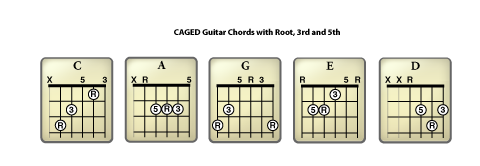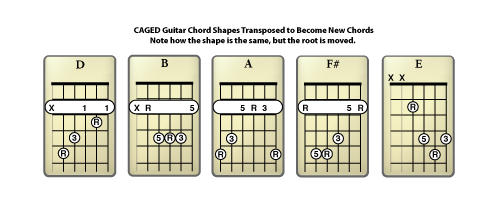The CAGED guitar system is a way of understanding how to play guitar chords in all keys by knowing the fundamentals five basic open chord positions. As you might guess, the five open chords used as the basis of CAGED guitar are the open C, A, G, E and D.
CAGED guitar teaches that if you know how to play basic C, A, G, E and D open chord shapes (with minor and other variations), and can identify the root notes within those shapes, then you can play chords in any key. Also by knowing these shapes all around the guitar neck, you will have a better understanding of how the notes lay out on the guitar and access a huge variety of chord voicings while you play.
Basic CAGED Guitar Chords
First let’s look at the chord shapes with their fingerings. Note that if need to learn these basic CAGED chords, we cover some basic chords here. Also remember that eMedia Guitar Method is the fastest way to learn these chords plus all of the other basics of playing the guitar.
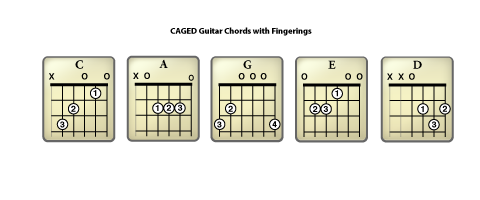 Some Basic Guitar Chord Theory – How Chords Are Made
Some Basic Guitar Chord Theory – How Chords Are Made
A chord is three or more notes played at the same time with a certain relationship between the pitches of the notes. The relationship between notes is referred to as intervals. For example, a C major chord combines the first, third and fifth notes of the C major scale (C, E and G). Since the first note of the C scale was the initial starting point when adding the other intervals on top, the C note is called the root of the chord. This root note determines the name the chord (a C chord in this case). If the chord was formed by starting with a D, the chord would be a D chord, and so on. The notes of a chord can be rearranged, creating different positions of the same chord which are called inversions. Three-note chords built with a root, third, and fifth are called triads.
Find the Root
This guitar chord chart shows where the intervals are located in our CAGED guitar chords. R is for the root, 3 is for the Third and 5 is for the Fifth. Knowing where the root is located is the key to being able to move the chord shape around the neck to quickly become a different chord.
Move Chord Shapes to Create Chords in Different Keys
Now that you know where the root of the chord is, simply move (transpose) the chord up the neck and put the root note on a different fret. This creates the same type of chord in a different key. The approach will seem familiar to users of eMedia guitar lesson software as it is seen in the lessons on how to play barre chords and power chords. Those lessons show how to make E and A chord shapes into moveable barre chords. For example, the E shape becomes a G chord by simply moving the whole shape up and creating a barre with your finger on the third fret.
To move the shapes you will need to learn how to barre with your first finger. Basically you are using your finger the same way the guitar nut is used in the normal open chord voicing. Here is a video to illustrate creating a barre on the first fret and using the E shape to create an F chord:
Using this idea, you can see how only using a single chord shape can deliver that chord in any key. Memorizing these basic CAGED chord shapes, their roots and the notes on the fingerboard, lets you create moveable chords that help you play songs in any key.
Know Your Guitar Notes
Now that you have all this power to create new chords, remember that you have to know all the notes on the guitar. Knowing your guitar notes lets you easily see where to put the CAGED chord shapes to create a new chord. Memorize this chart below, and always remember that the notes are in a simple A, B, C, D, E, F, G sequence and then the notes start over again. Also remember that there are 2 frets between each note, except for B to C and E to F where the note pairs are only one fret apart.
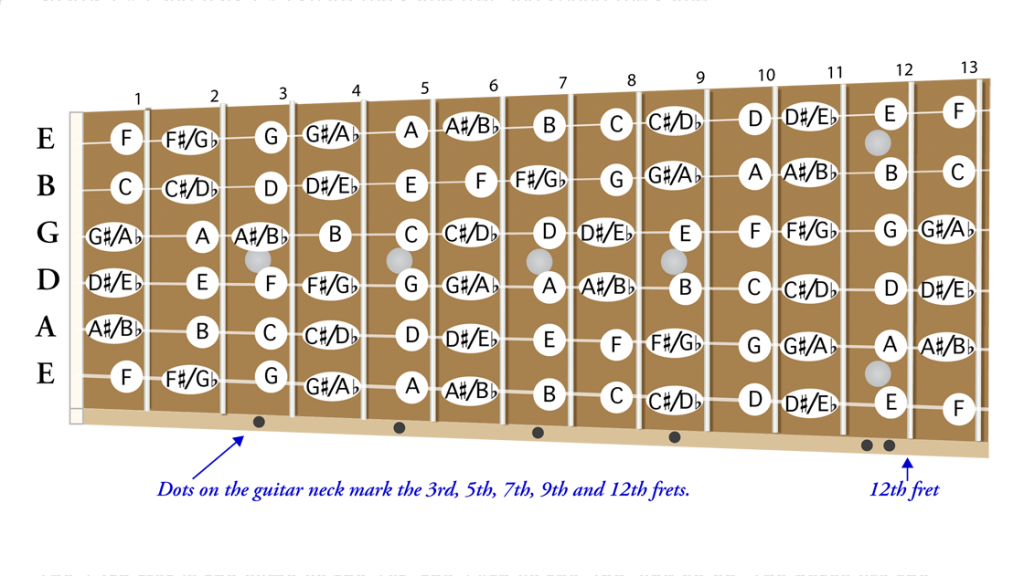
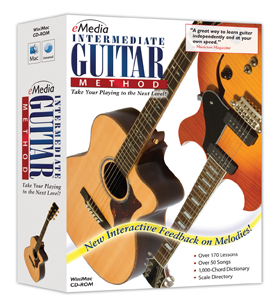 eMedia Intermediate Guitar Method is a great way to learn your intervals, chords and scales. Created with University of Colorado-Boulder’s Kevin Garry, Ph.D., it uses flash card exercises to improve your ear and other interactive tools. Also you learn popular songs and use guitar theory to help you learn how to play guitar solos. It’s like having your own 24/7 private guitar instructor.
eMedia Intermediate Guitar Method is a great way to learn your intervals, chords and scales. Created with University of Colorado-Boulder’s Kevin Garry, Ph.D., it uses flash card exercises to improve your ear and other interactive tools. Also you learn popular songs and use guitar theory to help you learn how to play guitar solos. It’s like having your own 24/7 private guitar instructor.
